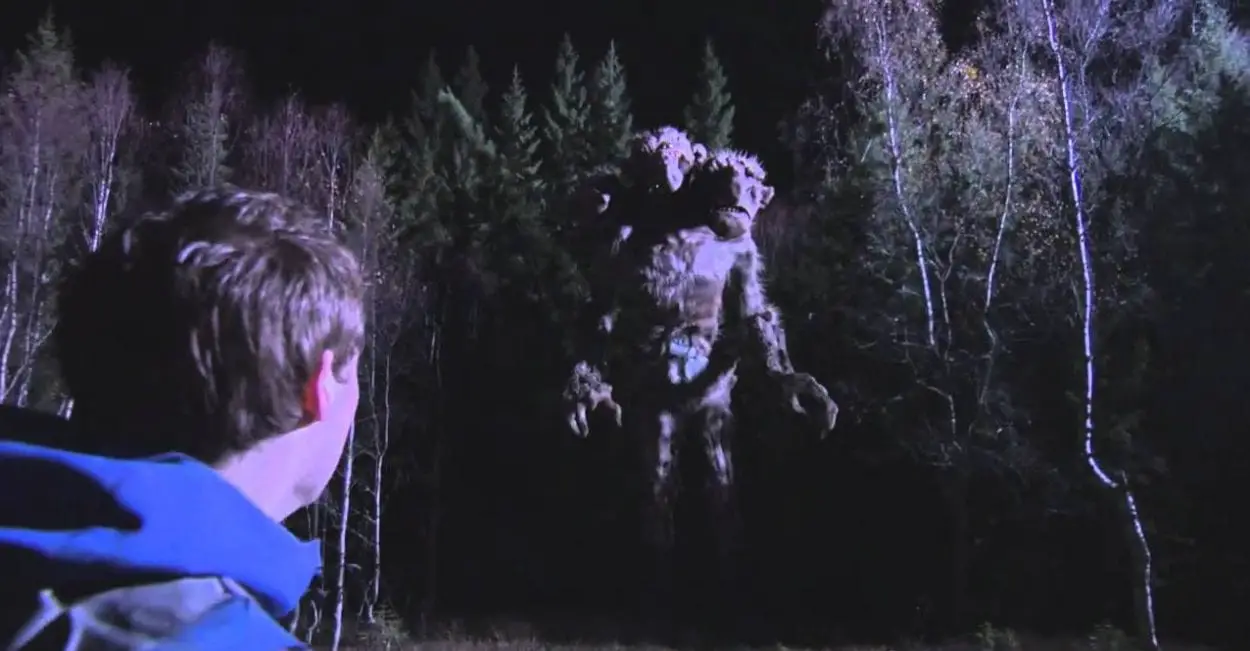At first glance, André Øvredal’s 2010 Troll Hunter looks like a movie that shares a lot of its DNA with The Blair Witch Project, but on closer examination it becomes evident that it is every bit as different as it is similar. It is true that the story of both Troll Hunter and the seminal American found footage horror is focused around a group of three college students who stumble upon something that they could never have imagined whilst filming a school project. Then you also have the portrayal of the footage in question as being authentic from the filmmakers, à la Blair Witch.
There is also the fact that both narratives are centered around folkloric tales—totally polar opposites in terms of the type of folklore but they are both folkloric stories nonetheless. It is true that the inspirational evidence is clear for all to see but that’s is where the similarities end. Whereas The Blair Witch Project focuses on a spine-chilling, assault on the senses type of style, Troll Hunter, on the other hand, is nearly borderline comedic. The cues it takes from American horror are obvious but it also seems to have borrowed its style from that of the mockumentary, such as shows like The Office or Parks and Rec.
Troll Hunter has this excellent ability of pairing the terror and confusion of its lead characters with this incredible level of tongue in cheek self-awareness. The young trio is the total manifestation of the feeling of the audience as the story unfolds. They share not only our bemusement of the events that are occurring but also our childlike curiosity. Then, as they peel back the layers of what they thought they knew and lay bare the fantastical reality, that is when we see the real strengths of Troll Hunter: the richness of the mythos behind the tale and most importantly how Øvredal brings this mythos to life.
The special effects that were used to create the trolls are absolutely astonishing, especially when you take into account that Troll Hunter is far from a large scale production. The creatures that lurk in the Norwegian night are magnificently monstrous. They are so real and textured, you really feel like you can almost reach out and touch them. It always amazes me when films of this scale can pull off special effects in this manner. When you see that the budget is only $3.5 million it really boggles the mind how they were able to conceive this story in such an impressive way.

It brings to mind Gareth Edward’s Monsters and how he created a true spectacle on a shoestring budget. I can’t stress how important it is for movies like Troll Hunter and Monsters to punch above their weight. It shows every one of what is possible when imagination and ingenuity are relied upon instead of just cold hard cash. Troll Hunter serves as an excellent reminder that when a small budget is utilized in the right way by the right people then the sky’s the limit. This is a sentiment that Øvredal took quite literally and his ambition allows Troll Hunter to soar well above the heights anyone could have ever expected.
The way the trolls are brought to life is brilliant and done so smartly, but another layer of the cleverness that Troll Hunter has is the foundational mythos that I briefly mentioned. It is amazing how in-depth the story goes into not just the lore but also the science behind these creatures. Throughout the trio’s journey alongside the titular Troll Hunter Hans (Otto Jespersen), we see an incredible array of trolls. We find out they are split into two groups: Mountain Trolls and Woodland Trolls, with each of the genera split into many subspecies that are vastly different from one another in terms of not only appearance but also in their habits and habitats.
Some of the trolls such as the Mountain Kings seem to be cave dwellers that hunt in packs, others like the Tosserlad are lowland solitary creatures that find their homes in the forests of Norway. We even see a Ringlefinch, a troll that has taken up residence under a bridge, a clear reference to the fairy tales of old. The encounter with the Ringlefinch on the bridge is definitely one of the most memorable of the entire film when it slams Hans down as he attempts to get a blood sample is borderline slapstick but is so well done that it just adds an extra string to Troll Hunter’s bow.

We find out as the story progresses that the troll’s behavior is becoming more and more erratic which we later find out is due to rabies. The bearer of this information is a vet, who is aware of the secret government operation to control the Norwegian troll population. When Hans finally manages to obtain the sample, he takes it to the aforementioned vet, this is where we see the science behind the folklore. I think it is always important for a movie that is attempting to pair the fantastical with the real to try and root it in science.
This helps the audience understand the story on a level that they can comprehend and it also gives movies like this a feel of authenticity and believability. It is much easier to understand that the reason for the trolls oftentimes volatile reactions to the sun if you can give a real-world reason for it. Instead of saying that it is a curse of magic it is explained with a biological reason. The reason is a vitamin D deficiency, the younger ones absorb it too quickly causing a systematic overload, which then results in an explosion. Whereas the elder of the species suffers from the opposite, the systems are too restrictive which leads to rapid calcification thus turning them to stone.
This scientific explanation for the folkloric elements of the story not only adds real-world credence to the story but it also helps the Troll hunter create real living breathing creatures with their bases in the world we live, in a way we can understand. Øvredal took the utmost care in making us understand that his creations aren’t just some mystical creatures. It was his attention to detail that prevented them from being silly, gaudy monsters. Instead, they were fully realized to an unexpected level and it was not just how real they were that was incredible but the scale in how they were brought to life was massively impressive.
We see this to maximum effect in Troll Hunter’s climax when Hans finally finds the troll responsible for the rabies outbreak. The troll in question is a gigantic behemoth known as a Jotnar. The rabid monstrosity allows us to view the true scale of Øvredal’s ambition for this piece. The end is an excellently paced action sequence, built with suspense as Hans tries to use the UV light on the top of his Land Rover. When that fails he tries to stay on the move, staying ahead of his target. This leads to an awesome scene of Hans trying to evade the enormous feet of the troll, the imagery used here us befitting of a summertime blockbuster.

Even though the trolls often take much of the narrative attention for themselves it is actually the troll hunter himself Hans that is the fulcrum that everything else is supported by. Hans could have easily have been just another macho seek, kill, and destroy type character which is what he seems on the surface, but in actuality he is much more complex. Otto Jespersen portrays the man as a tired civil servant that is tormented by what he has been asked to partake in, in the service of his country.
This is no more evident than when he recounts a hunt he went on during the ’70s. The cause of his hunt was due to a governmental incursion into troll-laden country to build tunnels. The way Jespersen conveys the pain and anguish of his memories of the hunt that he described as a massacre is excellently done. He tells of how he had to kill male, female, and child troll alike, even going as far as killing pregnant trolls. This is a rather dark scene in a movie that doesn’t tend to take itself too seriously but it is executed to perfection and really packs an emotional punch.
Depending on how you view the trolls this recounting can be said to be a metaphor for one of two things. If you see the trolls as an animal then you could say the incursion is another example of how we ruin natural habitats by human sprawl. That is if you view the trolls as animals but if you view them as an indigenous race then the incursion could be seen as a genocidal move for the benefit of modernization which would be something akin to what is occurring right now to the Amazonian tribes in the rainforests of Brazil. The trolls just like that poor tribespeople find themselves the victims of harsh acts all in the name of the spread of civility even if it is at the expense of an entire civilization.
When you go through it Troll Hunter has so much wrapped up in the guise of just another monster-filled found footage movie. Within its story, it covers so much, from the comedic to the bleakness of what Hans calls dirty work, to the intense action sequences. Troll Hunter is a full story that has layer upon layer of impressive filmmaking ability on display throughout. It shows that just like its titular hero that an underdog can upset the odds and maybe from time to time rub shoulders with the giants of this world, and on occasion even soar above.



